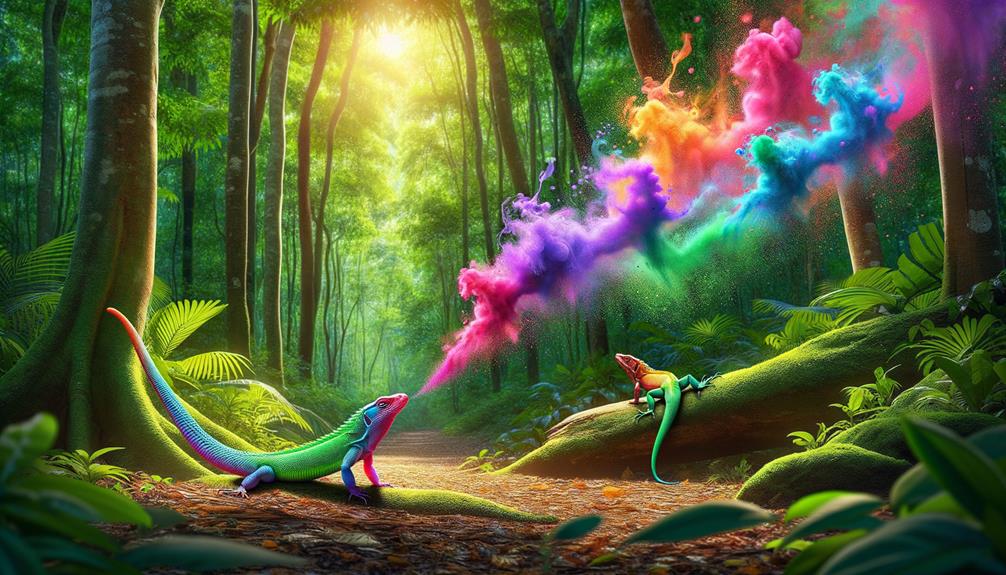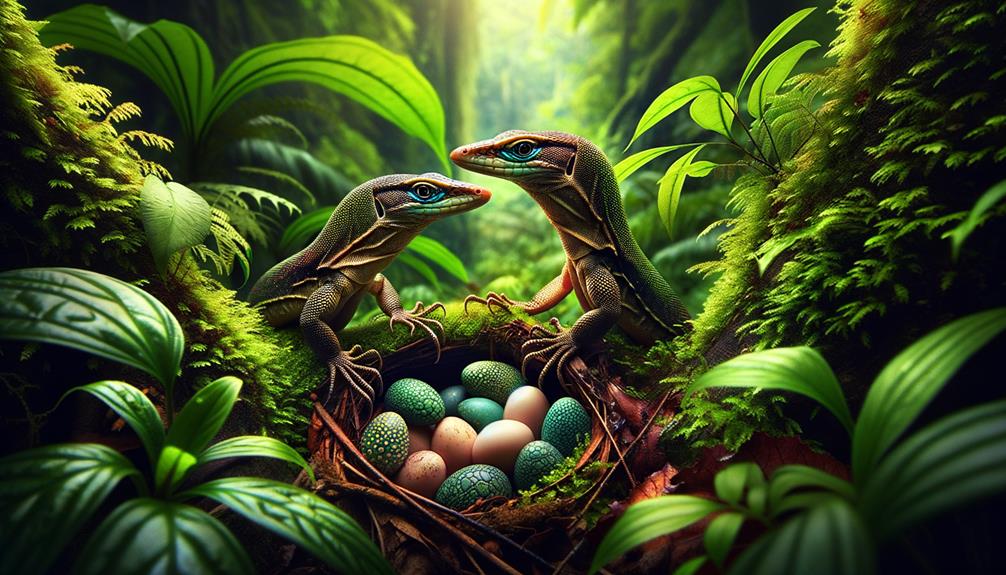Reptile courtship and mating rituals are a fascinating area of study. Lizards, for instance, use vibrant color displays to attract mates. Some species, like the sand lizard, can even change their skin tone to green. The eastern fence lizard has a unique way of showing off its bright blue patches – it twists its body to reveal them.
Vocalizations also play a crucial role in reptile mating. Anurans, in particular, use calls to reach potential mates through dense vegetation. Interestingly, larger males with deeper voices tend to have more success in finding a mate. Chemical signals are another vital aspect of reptile courtship. Males can detect female pheromones, which helps them locate and assess their readiness for mating.
Physical interactions between reptiles vary greatly. Alligator lizard males, for example, bite females during courtship, while boas engage in a form of wrestling. When it comes to parental care, reptiles exhibit a wide range of behaviors. Some species coil their bodies around their eggs to protect them. There is still much to be learned about these remarkable behaviors.
Key Takeaways
Male lizards showcase their vibrant colors and perform intricate body movements to snag a mate. In the anuran world, males use vocal calls to woo females, with larger males producing deeper, more alluring calls. Reptiles rely on pheromones to sniff out potential mates and assess their reproductive readiness. Some reptile species engage in physical displays of biting, gripping, and wrestling to seal the deal. When it comes to parental care, reptiles take different approaches, with some providing warmth and protection to their eggs, while others leave them to fend for themselves.
Visual Displays
Lizards have a fascinating way of communicating with each other through visual displays during the breeding season. These displays are not just for show; they serve as crucial signals to females about a male's suitability as a mate. For instance, sand lizards change their color from dull brown to vibrant green, making them stand out in their environment and signaling their readiness to mate.
Eastern fence lizards, on the other hand, twist their bodies to showcase bright blue patches on their throats and bellies. This display is specifically designed to catch the eye of a potential mate, highlighting their health and vitality. However, not every female is impressed. If a female isn't interested, she'll arch her back and jump away, clearly rejecting the male's advances.
These varied visual displays are vital for communication during the breeding season. They allow lizards to convey their breeding status and desirability, ensuring that the right message is sent to the right individuals. For males, these displays are a way to stand out and hopefully become the one chosen by a discerning female. By using these visual cues, lizards can effectively convey their message and increase their chances of finding a suitable mate.
Auditory Signals

While visual displays play a significant role in reptile courtship, auditory signals are crucial for species like anurans, which rely on vocalizations to attract mates across dense vegetation. These vocal calls serve multiple purposes: they draw females in and enable males to communicate with each other. When two males call in close proximity, they're signaling their readiness to breed and competing for the attention of nearby females.
Females, on the other hand, assess potential mates based on the characteristics of these calls. Lower-pitched calls, typically produced by larger males, are often more appealing to females, indicating a higher quality mate. The ability to distinguish conspecific calls from those of other species ensures that females select the right partner, which is vital for reproductive success.
Interestingly, changes in vocalizations and other breeding behaviors are synchronized with seasonal environmental cues. This synchronization guarantees that mating occurs at the most favorable times, increasing the chances of successful reproduction. The intricate relationship between auditory signals and environmental cues highlights the sophistication of anuran communication. By understanding these complex behaviors, we gain insight into the remarkable adaptability and complexity of reptile courtship rituals.
Chemical Communication

In the realm of reptile courtship, chemical communication plays a vital role, with pheromones acting as subtle signals that guide and attract potential mates. Many reptiles, such as garter snakes, heavily rely on these chemical cues. When a female garter snake leaves a scent trail, males can follow it directly to her. They detect these pheromones through their vomeronasal organ, a specialized sensory system.
This is how chemical communication unfolds:
- Detection: Males pick up on pheromones left by females, typically on the ground or vegetation, which helps them locate a potential mate.
- Identification: The chemical signals provide information about the female's reproductive status, allowing males to determine if a female is ready to mate.
- Attraction: Once a male finds the female's scent, he assesses her readiness further and prepares to mate with the female.
These pheromonal cues are more than just signals; they synchronize breeding cycles and ensure that interactions occur at the ideal time for reproduction. In newt species, males even deposit pheromone-rich spermatophores to entice females. Chemical communication, therefore, forms a silent yet powerful dialogue in the realm of reptile courtship.
Physical Interactions

Beyond chemical cues, reptile courtship involves intricate physical interactions that reveal the complexity of their mating rituals. Take male alligator lizards, for instance. One male often bites the female's neck or head, maintaining this grip for several days, showcasing remarkable dedication to the act. Sometimes, a second male joins in, creating a rare threesome that adds another layer to their courtship dynamics.
In some snake species, such as boas, males engage in a physical display that resembles a wrestling match. They twist around each other, biting necks to assert dominance and secure mating rights. This physical display is both a demonstration of strength and a prelude to the actual act. Male Boa constrictors take a more direct approach, crawling over the female and flicking their tongues as part of the mating process, which typically lasts under an hour.
Burmese pythons take their time, reaching sexual maturity in 4-5 years. When the female is ready, she can lay up to 100 eggs in a single breeding season, highlighting the significant reproductive potential in these reptiles.
Parental Investment

Parental investment in reptiles varies widely, with some species offering extensive care, while others abandon their eggs immediately after laying. Natural history has revealed fascinating insights into these diverse behaviors. For instance, female pythons and cobras coil around their eggs, providing warmth and protection until they hatch. In contrast, crocodilians take a more active role by constructing nests, guarding them, and even transporting hatchlings to the water.
- Pythons and Cobras: These species showcase their ability to protect and incubate eggs, which attracts females. The female coils around her clutch, ensuring ideal temperature and safety.
- Crocodilians: They build and fiercely guard nests. After the eggs hatch, the parent helps transport the young to a nearby water source, increasing their survival chances.
- Turtles: Turtles demonstrate minimal parental care, laying their eggs in a suitable spot and then leaving. The hatchlings are on their own from the moment they emerge.
Reptiles adapt to their environments in remarkable ways, balancing reproduction and survival. Habitat, resource availability, and evolutionary trade-offs influence parental investment strategies, highlighting the remarkable adaptability of reptiles.
Frequently Asked Questions
Do Reptiles Have Mating Rituals?
Reptiles have unique mating rituals that showcase their fascinating behaviors. From lizards' head-bobbing displays to snakes' intricate pheromone trails, each species has evolved its own way to attract a mate. These diverse rituals highlight the remarkable adaptability of reptiles in their pursuit of love.
What Is the Behavior of Courtship in Reptiles?
In reptile courtship, I've noticed some fascinating behaviors. Lizards and crocodilians use a combination of body movements and sound to attract a mate, while snakes rely on pheromones and touch. What's more, female reptiles have the ability to store sperm or even reproduce asexually.
How Do Reptiles Attract Mates?
Reptiles use a combination of sounds, visual displays, and scents to attract mates. For instance, male lizards will change color and perform push-ups to impress potential partners, while garter snakes release sex pheromones to lure in a mate.
Do Reptiles Have Erogenous Zones?
Reptiles do have erogenous zones, which play a crucial role in their mating behavior. These sensitive areas, including the cloacal region, head, neck, and limbs, serve as a guide for stimulating their partners and ensuring successful reproduction.



